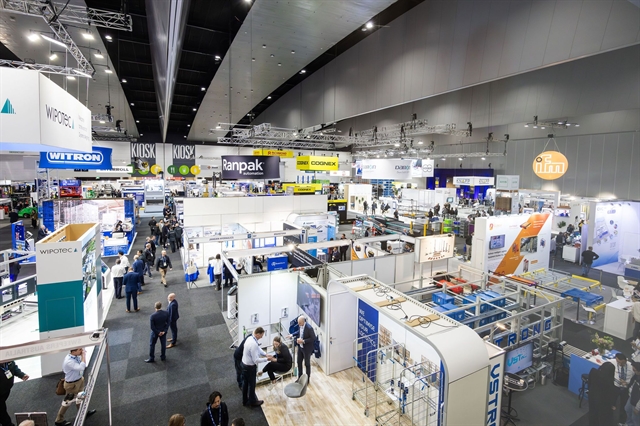 CeMAT Australia 2024 attracted more exhibitors than last year's event
CeMAT Australia 2024 attracted more exhibitors than last year's eventThe busy exhibition area at CeMAT Australia 2024 was dominated by automation suppliers, but there were a number of ‘traditional’ materials handling machines on display.
The world’s largest forklift maker was represented for the first time by its local subsidiary, Toyota Materials Handling Australia, which exhibited alongside automation stablemate and returning exhibitor Vanderlande. The forklift maker showed off its automated reach truck, a new automated counterbalance stacker and autonomous forklift and shuttle integration, using the Autopilot CDI 120 which is programmed to work alongside manual operators and complete all tasks safely.
China’s Xilin debuted a number of products at CeMAT, including some new electric stackers designed especially for the Australian market. The stand featured an electric straddle stacker with narrow legs (CTDK15R-EN), the CQDH15K-III electric reach stacker with single scissor forks and a number of order pickers and reach trucks, including one with a 14.5 m mast.
Company spokesperson Alice Wei notes that Australian sales have grown since the company’s last CeMAT display last year – rising 30% in the second half of 2023.
“Australia is a special market which has more different requests than other markets like the US or Europe,” she explains, adding that Xilin already has a number of enhancements tailored for the local requirements.
Attachment maker Cascade showed its smart products including its Forks + Sensor Forks equipped with a built-in digital camera and sensor package- as well as an Electric Sideshifter from the Cascade Electrix line.
Seamus Dunne, general manager of Cascade Australia, says business activity in Australia over the past 12 months has been strong. Developments have included the appointment of Michael Green as national sales manager, while Cascade continues to make investments in process efficiencies and sustainability initiatives in its facilities and its products.
“We see a significant move to the use of attachments with embedded technology and a drive towards automation. Customers are seeing the value that smart technologies bring to operational efficiency gains (energy and productivity) or reduction in costs like eliminating product damage,” he adds.
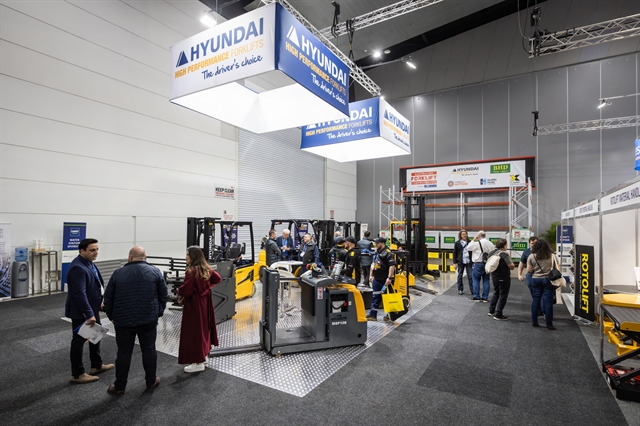 Hyundai debuted its 20BE-X forklift
Hyundai debuted its 20BE-X forklift
Hyundai Forklifts Australia had an extensive range of machines at its stand, with operations manager Nathan Owens explaining that the complete battery electric range is now lithium ion-compatible. “Unlike other brands, you can buy any of the Hyundai battery electric trucks now with a lead acid battery and if in 12 months’ time the customer decides to change to lithium, they simply remove the lead acid battery and fit the lithium ion battery and plug it in and away it goes. No other hardware or BDI is required - the truck will fully integrate and speak with the new lithium battery and BMS system,” he says.
Owens tells Forkliftaction News that Hyundai as a brand in Australia “is moving forward at a rapid rate”.
“We have recently secured a major 3PL company, supplying sites in Australia, New Zealand, India and South Korea.
“We have the release of our new four-wheel counterbalance BE-X models which was used in the forklift challenge and further releases to be announced shortly.”
Ingleburn, NSW-based Industrial Forklift Equipment made its CeMAT debut this year, showcasing its new ProfitMax VNA articulated forklift which the company claims can increase warehouse capacity by 30-50% and fulfil the work of a reach truck and counterbalance combined. It also boasts an inbuilt camera and laser in the tip of the tyne.
Business development manager Kevin Kenny notes substantial growth in the south Sydney region, aided by the construction of the Western Sydney Airport. He cites CBRE Australia research indicating that approximately 15% of the new floorspace expected to be delivered in Sydney between 2023 and 2027 will come from multi-storey developments. “The growth of e-commerce and the need for efficient delivery to major urban areas within a few hours are driving the demand for multi-storey warehouses,” he says, adding that this demand is fuelling demand for IFE’s products.
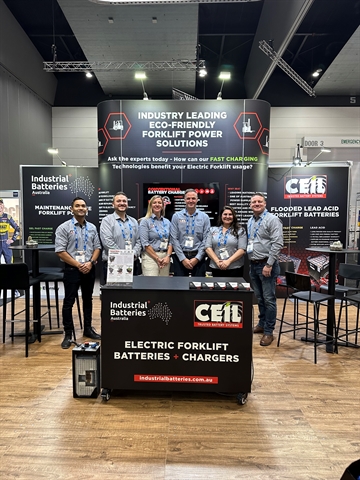 New products and parnters were revealed at the IBA stand
New products and parnters were revealed at the IBA stand
Industrial Batteries Australia had a very successful CeMAT, according to managing director David Cooper, who notes the launch of Eternity Technologies’ QUASAR Fast Charge Gel technology as a show highlight.
“Over the past 12 months, IBA has solidified our national presence with our new South Australian branch and partnerships with both fast-charge lithium ion and fast-charge GEL battery manufacturing partners, when the supply of a maintenance-free power option is required external to standardised flooded lead acid,” he adds.
Cooper points out that the Australian materials handling market has seen a significant increase in battery electric machine utilisation. “There is an evident drive by all businesses nationally to convert to battery-powered options in what is viewed globally as a mission for more sustainable and eco-friendly materials handling options. This has also heavily involved fast charging and suitable fast-charge battery variants, supplied in order to create application flexibility, with these products utilised to extend daily machine run times, without negative impact on the battery to ensure product longevity,” he explains.
Automation innovation
AutoStore had a stream of visitors watching its new FusionPort Workstation and R5 Pro Robot in action, while there were also demonstrations of the space-saving ConveyorPort solution.
Jason Wu, AutoStore business development manager Australia and New Zealand, notes that the recent opening of a new factory in Thailand will enable AutoStore to double its production capacity and meet growing demand for its automated fulfilment solutions.
The company’s regional expansion in the last year has seen the appointment of new Australian business development manager Julian Brancaccio (currently also president of the New South Wales Division of the Supply Chain & Logistics Association of Australia).
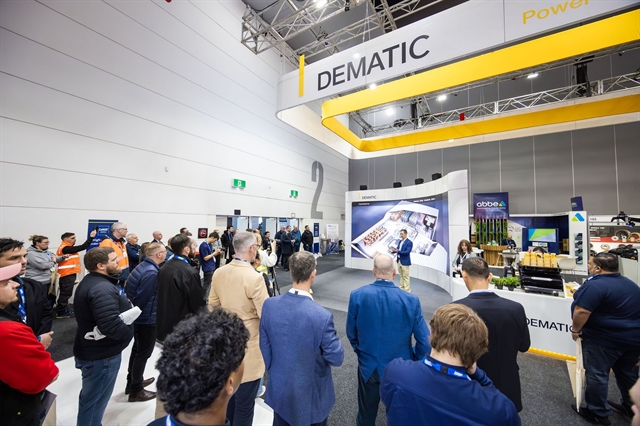 Dematic APAC marketing director Phil Makowski demonstrates the company's tech suite
Dematic APAC marketing director Phil Makowski demonstrates the company's tech suite
At the Dematic stand, visitors got two opportunities each day to experience the Virtual Hub, an interactive 3D warehouse visualisation which led guests through virtual warehouse environments, showing Dematic automation solutions in action.
“With supply chain and warehousing challenges around labour, land availability and increasing customer service levels, Dematic is focusing on the latest technologies that maximise productivity, storage, and throughput capacity, speed and accuracy, while providing flexibility and agility,” says David Rubie, ANZ sales director - integrated systems and mobile automation at Dematic.
“This year sees the first appearance of Colby Storage Solutions by Dematic at CeMAT,” says Lee Koutsos, director - real time logistics and Colby Storage Solutions ANZ at Dematic. Visitors were able to see up-close the design features of the Australian-made ColbyRACK pallet racking system.
China’s Hai Robotics showcased a range of innovative robotic solutions, including the flagship HaiPick System 3 goods-to-person solution.
Will Fan, General Manager, ANZ, tells Forkliftaction News that his company continues to see double-digit sales growth, driven by the increasing demand for warehouse automation solutions.
“We have already signed several projects for our latest product, HPS3, and have secured business or are currently collaborating with several renowned top companies in Australia,” he says, citing contracts and partnerships with Körber Supply Chain, BPS Global and CH Racking.
The company has reached 100 staff members, and recent movements have seen the hiring of experts in robotics, software development and project management to drive product development and market penetration efforts.
Swisslog had its latest AutoPiQ solution in action, showing visitors the newest automated gripping technology, modular storage and order picking solutions, powered by intelligent software.
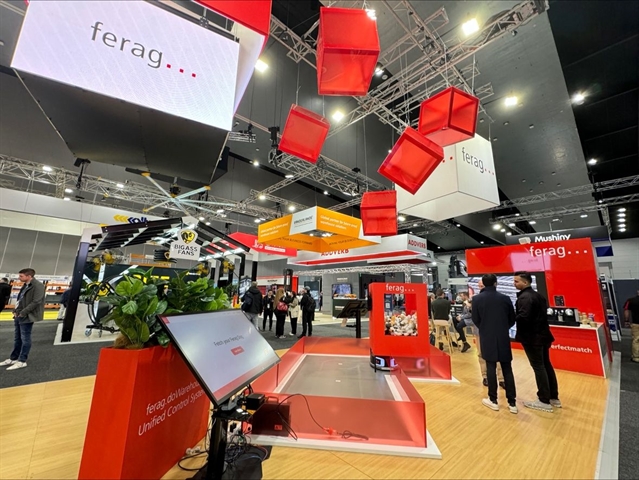 The Ferag booth attracted strong interest
The Ferag booth attracted strong interest
Swisslog developments since the last CeMAT include the launch of the ItemPiQ robot with new grippers. Using artificial intelligence, the ItemPiQ robot picks the best gripper between half a dozen options after it assesses the product or box needing to be picked.
As the market grows, the company has made some key appointments, including Joseph Kutek, who was named as sales consultant for the food and beverage industry, and Elke Pistono, who was appointed sales manager for AutoStore grid-based warehouse automation systems.
Sean Ledbury, head of sales and consulting, notes that flexible infrastructure technologies such as mobile robotics and AGVs are continuing to play a larger role in levelling the playing field for smaller organisations.
He also notes the growth of reshoring, which is shifting the focus back to pallet handling systems: “Australian and New Zealand-based businesses are re-centring their supply chains to improve resiliency. This is driving development of high-bay warehouses that support distribution of palletised products and that will result in increased investment in pallet handling technologies, particularly crane-based and shuttle-based ASRS (Automated Storage and Retrieval Systems).”
SSI Schaefer sponsored the Knowledge Theatre at CeMAT Australia 2024 and a number of its experts presented over the three days.
SSI Schaefer used the event to show off its WAMAS warehouse management systems combined with its augmented reality app. Comprised of coordinated modules and solutions, WAMAS can be implemented using a “mix and match” approach to meet specific customer needs.
Brett Thirup, managing director, Australia and New Zealand, tells Forkliftaction News SSI Schaefer has experienced robust sales growth over the past year, with its success attributed to “our strategic focus on expanding our market presence and deepening our engagement with existing customers”.
“We have seen a notable increase in demand for our automation solutions, reflecting the industry's growing recognition of the value of advanced logistics systems,” he adds.
Since last CeMAT, the company has also secured several significant accounts, including “a landmark project with a leading retail chain, where we are implementing a comprehensive automated storage and retrieval system”.
“This partnership underscores our ability to deliver customised solutions that address complex logistics challenges.”
To support this growth, SSI Schaefer has expanded its team, with several new experts in sales, engineering, service and project management.”
Looking at market trends, Thirup notes that the Australian materials handling and logistics market is currently undergoing significant transformation, driven by several key factors that are reshaping the landscape. These include technological advancements, e-commerce growth, sustainability initiatives, labour market challenges, and the need for supply chain resilience.
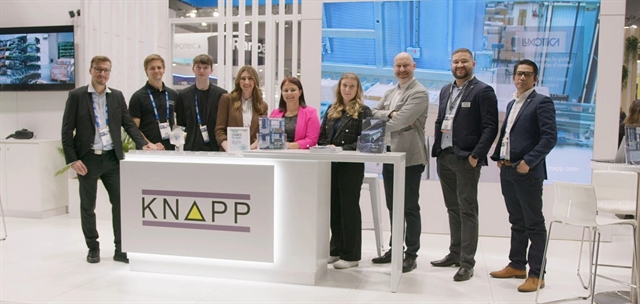 The Knapp team at their booth
The Knapp team at their booth
Besides a number of presentations in the Knowledge Theatre, Knapp showcased its Autonomous Mobile Robots (AMRs), especially the Open Shuttles designed for distribution centres.
Michael Kemeny, managing director of Knapp Australia, notes that the company has grown significantly in the past year, “securing five new installations across retail, food retail, healthcare and industry solutions. We've (also) expanded our local service desk to offer faster support, enhancing our customer satisfaction and operational efficiency."
Knapp, which this year celebrated its 10th anniversary in Australia, has expanded its Melbourne office and added new team members to its customer service department, ensuring better support for clients.
“Our focus is on helping local businesses become more productive and competitive through innovative solutions," he says.
According to Kemeny, “The Australian market faces ongoing challenges like labour costs and real estate expenses, pushing companies toward automation. Despite these pressures, Australia still trails behind Europe and the US in service levels and stock accuracy. Automation is key to bridging this gap and boosting competitiveness."
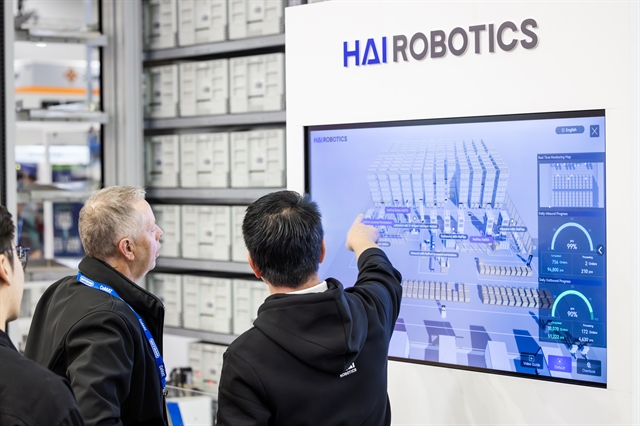 Hai Robotics showcased a range of innovative robotic solutions
Hai Robotics showcased a range of innovative robotic solutions
Tompkins Robotics used CeMAT to launch its latest autonomous mobile robot for sortation, tSortPost. The new product can sort parcels, operate as a tote or carton delivery system to move containers around a warehouse, or feed an order consolidation system.
According to local partner Sean Hewat, the Australian materials handling and logistics market continues to show promising growth year on year. “This has been driven by e-commerce growth which is driving demand for more sophisticated and flexible logistics solutions,” he says.
“Australians' adoption of technology continues to create opportunities for automation, data-driven solutions, and improved transparency within the logistics sector,” he notes.
At Körber’s booth, demonstrations of the 3D Sorter Solution handled over 3,000 units during the event.
Visitors showed strong interest in flexible and scalable automation solutions, while affordability as was another key concern.
“Pre-COVID, there was a real focus on large-scale automation projects with affordable commercial real estate readily available,” says Peter Zann, APAC sales manager AMR at Körber. “The landscape has changed post-COVID, as consumer buying demand evolved, it’s refreshing to see businesses of varying sizes have the confidence to now consider and implement AMR technology as their first step to automate their supply chain operations.”
Nikki Jones, APAC director of marketing at Körber, notes: “While everyone’s requirements are unique, the goal to improve efficiencies, productivity and streamlining processes remains common and top of mind across the industry.”
- CeMAT Australia returns to Sydney next year, with the event scheduled for July 22-24 at The Dome, Sydney Olympic Park. The focus will be expanded with the addition of a new Processing & Packaging Pavilion – powered by APPMA, within the co-located Industrial Transformation Australia event.
Be sure to visit our CeMAT AUSTRALIA gallery. If you missed last week's report on the highlights of the Knowledge Theatre presentations, you can check it out here.